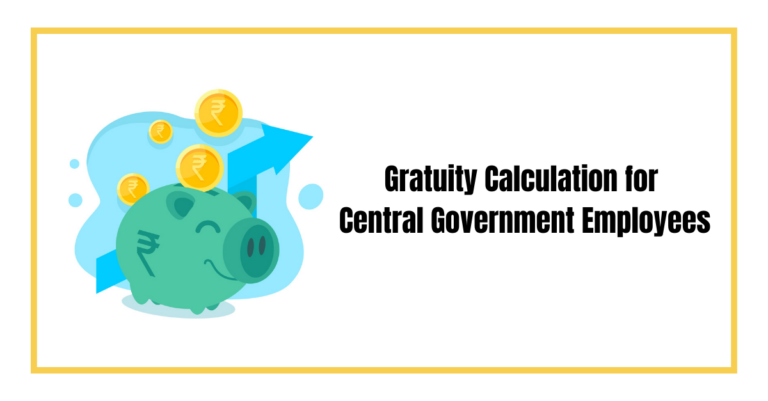Learn in detail about the formula implemented in calculating retirement gratuity for employees in this blog. This blog has also shared a detailed analysis of the Gratuity Payment Act of 1972. In this article let us see how retirement gratuity is calculated.
How is Retirement Gratuity Calculated:
The retirement gratuity is calculated by using the following formula –
1/4th of an employee’s monthly basic pay + DA (dearness allowance) drawn on the retirements date for each completed half-yearly period of qualifying service.
Do you wish to know how to calculate retirement gratuity in India? If yes, then you have come to the right place. But before we move on to the calculation specifications and criteria for gratuity eligibility in india , let us give you a very simple description of what gratuities are.
Basically, a gratuity payment for employees is a pension scheme designed for all the professionals hired by a company in their field of expertise. The amount is credited to the employee’s account once he successfully retires after providing a continuous service of more than five years to the same employer.
How is Retirement Gratuity Calculated: Gratuity for Employees – Eligibility
The only eligibility barrier appears to be the service clause for a minimum of five years. The Gratuity Payment Act was last amended on 1st April 2021. In the Act, the eligibility criteria have remained more or less the same. Still, the salary structure has undergone a few changes to favour the increased gratuity rates for relatively senior employees who have completed five years or more at the company.
The eligible candidates must fit under the criteria of superannuation as per the Gratuity law of 1972. This infers that they must get the gratuity amount based on the total number of consecutive working days. There are 26 working days per month, and the employer overlooked minute leaves due to temporary illness. The business’s market condition shall influence no circumstances.
An employee can claim his gratuity amount once he decides to resign from his job position or if there is a mutual end of the contract initiated from the company after a job tenure of 5 years. The sum of money could also be available before the maturation period, i.e., five years, if enough evidence supports the employee’s mental or physical disorder resulting from an accident. The same rule is applicable if an employee dies during his job period.
The amendments made in 2021 revised some of the withdrawal laws regarding the eligibility of gratuity for employees after death which is as follows:
- If an employee dies within one year of employment, his family is furnished an amount equivalent to 2 times his monthly salary;
- If the job period lies between more than one year to less than five years, then six times the basic net salary is paid;
- The company provides 12 times the salary if one dies between 5 – 11 years of completion of service;
- For tenures exceeding 11 years but less than 20 years of service, the disbursed gratuity for employees sums up to 20 times his salary;
- Suppose the period exceeds 20 years of continuous employment. In that case, emoluments of half-month for each six-month tenure are calculated and credited a maximum of 33 times.
Calculation of Retirement Gratuity
All employees currently working in government or private organisations are eligible for gratuity pay at retirement. They have completed at least five years of service under the same employer. The maximum limit of gratuity depends on the company that has hired the staff. Still, legislation determines the minimum limit of gratuity for employees. Taxation is levied if the gratuity amount exceeds 20 lakhs at retirement. The formula applied for the calculation of gratuity differs for those who do not fall within the Gratuity Act of 1972.
For the staff under Gratuity law, the calculation is done as (last salary amount) x (the number of years the concerned person has provided his service to that company) x 15/26. They must be working for any organisation certified by the central government. They must have a minimum of 10 employees stationed at each branch or workplace.
The last procured salary of the employee and the total service period become the benchmark determinants for this category of employees. For employees who work in companies that do not fall within the provisions of the Gratuity law, it is not assured whether they will receive a gratuity amount or not. If given to such employees, the gratuity for employees will be tax-free. The formula varies from one company to another.
What is the Latest Guideline Released Regarding Gratuity for Employees?
The new law mentions that the employer cannot provide an employee with an allowance tending to exceed half of his salary. Also, the employers now have to increase the monetary amount of basic pay to compensate following this rule.
Classification of Employees
The full-time employees who work in the private sector get gratuity pay at the time of retirement from the company. Private companies hire specialists who are experts in specific fields. They are also eligible for gratuity, but their payment is disbursed through contractors who introduce these employees to the employer. Government employees receive gratuity amounts that are not subjected to taxation. The number of service years has been rounded off if an employee works for more than six months of a year after completing the fifth year.
Conclusion
The employer calculates gratuity for employees to determine the amount that shall be credited to the staff at the time of retirement. Initially, taxes were levied if the gratuity amount was more than ten lakhs. The maximum limit has been extended to 20 lakhs, below which the sum is not subject to the tax levy.
This change was incorporated through Section 10 of the law governing the income tax of Indian citizens. The firms must be at least twelve months old and employ at least ten staff to come under the Gratuity Act of 1972. The gratuity formula for employees who had to discontinue for physical or mental disorders or those who died during work tenure is different. It has been discussed in detail in this blog.
Also read:










